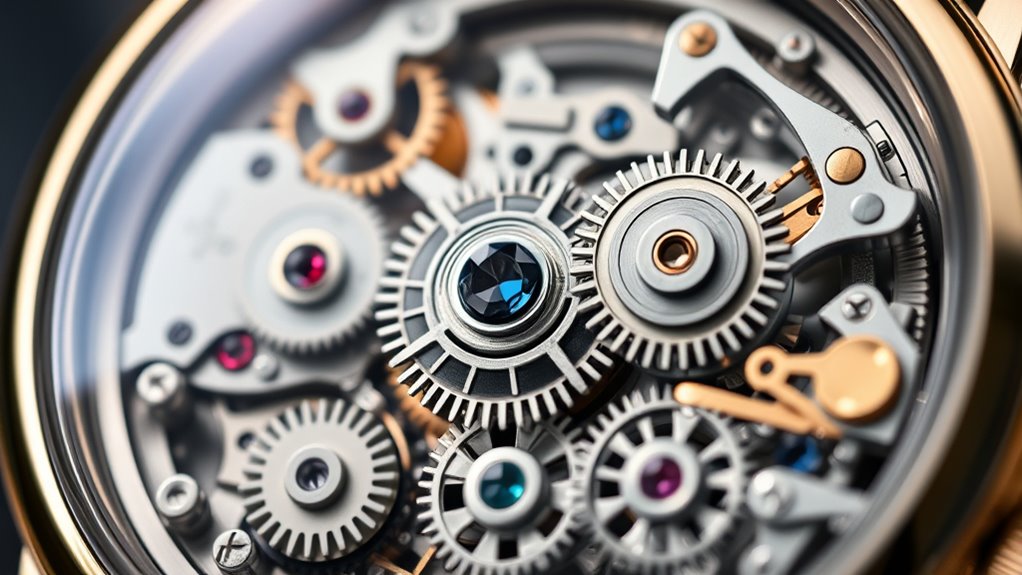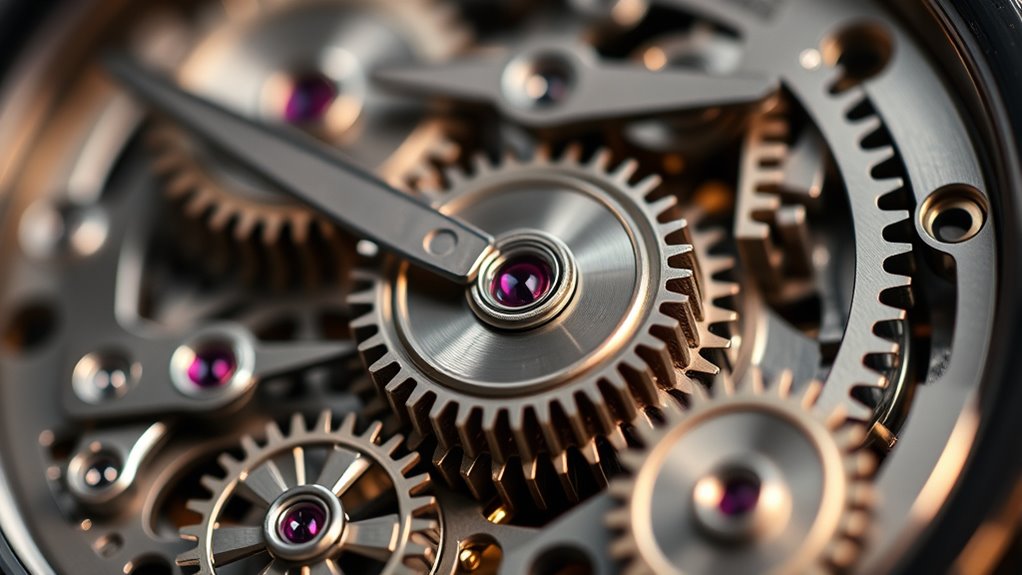Complicated watch movements rely on tiny gears, levers, and intricate mechanisms working together precisely. They include features like calendars, moon phases, chronographs, and astronomical displays, all powered by specialized gear trains. Craftsmanship guarantees these parts mesh perfectly for accuracy and durability. Advanced designs even incorporate automatic adjustments for leap years or month lengths. If you explore further, you’ll discover how engineers and artisans push the boundaries of precision and artistry in watchmaking.
Key Takeaways
- Complex gear trains and levers coordinate multiple complications like calendars, moon phases, and chronographs for seamless operation.
- Specialized coupling mechanisms and cams engage or disengage functions without disrupting core timekeeping.
- Precision engineering and calibration ensure synchronization and accuracy across added features within compact movements.
- Modular design and advanced manufacturing techniques facilitate integration and maintenance of multiple complications.
- Artistic finishing and intricate assembly enhance both functionality and aesthetic appeal of complicated watch movements.
Understanding the Core Components of Complex Movements

Understanding the core components of complex watch movements is essential to appreciating how these intricate timepieces keep accurate time. The mainplate acts as the foundation, supporting and anchoring all other parts to maintain stability and precise alignment. Attached to the mainplate are bridges that hold the gear train, which transmits energy from the mainspring through a series of wheels and pinions, controlling the movement of the watch hands. The escapement works with the balance wheel to divide this energy into equal oscillations, ensuring consistent timekeeping. The balance wheel swings back and forth, regulating the release of energy and maintaining accuracy. These core components collaborate seamlessly, forming the backbone of a sophisticated watch movement that balances precision with craftsmanship. A thorough understanding of quality assurance ensures that each component functions flawlessly, contributing to the overall reliability of the watch. Regular calibration of the movement is also vital to maintain its accuracy over time. Additionally, meticulous assembly and regular maintenance procedures are crucial to sustain the movement’s performance over time.
How Calendars and Date Functions Are Engineered

Watchmakers engineer calendar and date functions by designing specialized gear trains and discs that display the day, date, month, or moon phase, often integrating seamlessly with the main movement for synchronized operation. Simple date windows use a rotating disc with numbers passing under an aperture, advancing automatically at midnight via a date-driving wheel connected to the movement. Complex calendars, like annual and perpetual types, incorporate additional gears and levers to automatically adjust for varying month lengths and leap years, minimizing manual corrections. Large date displays utilize two separate discs for tens and units, driven by independent gear trains to ensure precise, legible changes. Advanced calendar complications also feature moon phase displays, driven by a calibrated cam and wheel system, requiring meticulous engineering for long-term lunar cycle accuracy. Incorporating layered textures and materials can further enhance the visual appeal and functionality of these intricate mechanisms. Additionally, modern innovations in automation enable these calendar systems to operate with increased precision and fewer manual interventions, elevating the overall reliability of the timepieces. Understanding the material selection involved in crafting these components is crucial for ensuring durability and optimal performance over time.
The Intricacies of Chronograph Mechanisms

The core of a chronograph’s complexity lies in its coupling mechanism, which precisely engages and disengages the gear train to control the stopwatch functions without disrupting the watch’s main timekeeping. This involves a clutch lever or a heart-shaped cam that connects the chronograph to the main gear train, allowing smooth operation. For example, a flyback chronograph lets you reset and restart instantly with one push, thanks to its intricate coupling and brake system. Split-seconds chronographs feature an extra seconds hand that can stop independently, enabling you to time successive events. Additionally, the safety features built into many modern watch movements help prevent damage during operation, similar to safety features in heated mattress pads.
Exploring Astronomical and Complication Features

Astronomical and complication features elevate watches beyond simple timekeeping by integrating precise mechanisms that depict celestial movements and calendar variations. You’ll find moon-phase complications, which use rotating discs and gear trains to display the lunar cycle accurately over 29.5 days. Calendar complications, including perpetual and annual calendars, automatically adjust for different month lengths and leap years through intricate gear arrangements. These mechanisms often involve multiple gear wheels and levers working together seamlessly. Additionally, celestial movement displays, such as star charts or sidereal time indicators, rely on meticulously crafted gear trains to track celestial bodies’ positions. These features demand exceptional craftsmanship, with some high-end watches incorporating hundreds of tiny parts to guarantee precision in representing astronomical phenomena and calendar changes over time. The design and assembly of these complications require a deep understanding of gear train mechanics and precise calibration to ensure reliable operation throughout the watch’s lifespan. Furthermore, the integration of complex mechanical systems involves careful synchronization to maintain accuracy in representing astronomical data over extended periods. Incorporating precise calibration techniques ensures these complex mechanisms function correctly over many years, highlighting the skill required by master watchmakers.
The Role of Gear Trains and Levers in Advanced Movements

You’ll see that the precision of gear engagements is essential for accurate timekeeping and smooth operation of complications. Levers control these gear trains, responding precisely to signals or user inputs to activate features like chronographs or calendars. Understanding how these components work together reveals the meticulous engineering behind advanced watch movements.
Precision of Gear Engagements
Achieving high precision in gear engagements is essential for the accuracy of advanced watch movements, and this depends on the meticulous design of gear train and levers. You rely on gear teeth that are precisely shaped with specific profiles, like Swiss lever escapement teeth, to ensure smooth meshing and minimal energy loss. Jewel bearings at pivot points reduce friction and wear, helping maintain consistent gear engagement over time. The engagement of gears is carefully regulated by levers and escapements, which minimize backlash and ensure reliable power transfer. Synchronization of gear engagements in complications like chronographs and calendars requires precise calibration to prevent slipping or misalignment. Additionally, the integration of AI-powered testing methods in manufacturing can identify potential issues early, further enhancing precision. Ultimately, the careful engineering of gear train components ensures the high accuracy and durability of your watch’s movement, supported by precise gear profiles that optimize meshing and energy transfer, and utilizing advanced manufacturing techniques to uphold tight tolerances. Furthermore, implementing rigidly maintained tolerances throughout the gear train assembly further enhances overall movement stability and precision.
Lever Functionality and Control
Lever mechanisms are essential in advanced watch movements because they precisely transmit and regulate energy between different components. They interact with gear trains and pivoted arms to control the activation of complications, such as moon phases, calendars, or tourbillons. When a complication is triggered, the lever’s position ensures accurate engagement, enabling smooth operation. Gear trains connected to the lever transfer rotational motion, converting it into linear or reciprocating movement needed for complex functions. The design of these levers and gear trains must minimize friction and backlash to maintain precision. Properly functioning levers coordinate the intricate steps involved in activation, ensuring each complication operates reliably and accurately. This system forms the backbone of sophisticated watch movements, enabling meticulous control over multiple functions. Additionally, the mechanics of the gear train play a crucial role in ensuring synchronization and efficiency within the movement, highlighting the importance of precise energy transfer in complex horology. Understanding the minimization of friction is vital for maintaining long-term accuracy and durability of these mechanisms, especially considering the delicate balance required for complex complication activation.
Decoration and Finishing Techniques in Elaborate Movements

You’ll notice that decoration techniques like Côtes de Genève patterns, perlage, and circular grain add striking textures to movement surfaces. Hand-engraved details, including motifs on bridges and rotors, highlight artisanal craftsmanship. These finishing touches not only enhance visual appeal but also demonstrate the watchmaker’s meticulous attention to detail.
Côtes De Genève Patterns
Have you ever noticed the elegant, wave-like lines adorning the bridges and plates of a luxury watch movement? These are Geneva stripes, a signature finishing that elevates a movement’s aesthetic appeal. Created through a meticulous process involving a specialized abrasive tool, the pattern features evenly spaced, undulating lines that reflect light beautifully. This decorative technique not only enhances the visual allure but also conceals minor imperfections from manufacturing and assembly. Côtes de Genève showcase the watchmaker’s craftsmanship and attention to detail, serving as a hallmark of haute horlogerie. When you observe these patterns, you see more than decoration—you witness the dedication to excellence that defines a truly refined movement. Geneva stripes symbolize both artistry and quality in high-end watchmaking.
Perlage and Circular Grain
Perlage, also known as circular graining, is a decorative finishing technique that enhances the surface of a watch movement through overlapping, tiny circular patterns. You apply perlage on movement surfaces like the mainplate and bridges using a rotating abrasive tool, creating a reflective, elegant pattern. This finishing technique not only adds visual appeal but also showcases your craftsmanship and attention to detail. The process requires meticulous manual work, with specialized tools like abrasive brushes or rotating wheels to ensure uniformity and precision. Circular graining helps prevent corrosion by forming a protective layer that minimizes exposure to moisture and dirt. By carefully aligning and measuring each pattern, you demonstrate mastery in finishing techniques, elevating the overall quality and aesthetic of high-end watch movements. Additionally, understanding finishing techniques enhances your appreciation of the intricate artistry involved in horology. Incorporating durable materials in the process can further improve the longevity of the decoration and the movement itself. Moreover, selecting precise measurement tools ensures consistent pattern quality, which is crucial for high-precision finishing. Proper tool maintenance is essential to preserve the sharpness and effectiveness of your abrasive tools, ensuring consistent results across multiple pieces.
Hand-Engraved Details
Hand-engraving transforms functional watch components into miniature works of art by meticulously carving intricate patterns and motifs directly onto movement parts. These artisans use specialized tools like gravers and loupes to create precise designs that highlight bridges, rotors, and plates. The detailed hand-engraving enhances the movement’s aesthetic appeal and showcases extraordinary craftsmanship. Finishing techniques such as snailing, perlage, and Geneva stripes complement the engraved details, adding depth and richness to the overall appearance. When you see a movement with hand-engraved elements, you’re witnessing the pinnacle of artisanal skill, which not only boosts the watch’s visual allure but also its exclusivity and collectible value. This meticulous craftsmanship transforms a functional device into a treasured piece of art.
Innovations and Challenges in Designing Multi-Function Watch Movements

How do watchmakers navigate the intricate balance between adding multiple complications and maintaining essential performance? They leverage innovations in engineering to manage the complexity of multi-complication movements. Modular movement architecture allows easier addition and repair of functions, while miniaturization techniques enable ultra-thin calibers like Patek Philippe’s Calibre 89. These advances help incorporate numerous complications without sacrificing space. Additionally, utilizing advanced manufacturing techniques allows for even more precise and reliable component production. The integration of robotic assembly has further enhanced the precision and consistency of intricate components. However, challenges remain—extra functions can drain power reserve and impact accuracy. To address this, watchmakers use innovative escapements, such as the constant-force escapement, which stabilizes energy delivery. Incorporating multiple complications demands precise engineering. Innovations improve repairability and customization. Managing power reserve ensures consistent performance. Miniaturization pushes the limits of movement design.
Frequently Asked Questions
What Makes a Watch Complicated?
You might wonder what makes a watch complicated. It’s the extra features beyond just telling time, like calendars, chronographs, or moon phases. These add layers of gears, levers, and springs, making the watch intricate to assemble and repair. The more functions it has—such as perpetual calendars or multi-time zones—the more complex it becomes. These details require precise engineering to guarantee everything works seamlessly together.
What Is the Mechanism of Watch Movement?
Did you know that a mechanical watch movement contains over 100 parts working in harmony? When you ask about its mechanism, you’re exploring a finely-tuned system where a mainspring stores energy, then releases it through gears and levers. The escapement and balance wheel work together to regulate this flow, ensuring your watch keeps accurate time, whether it’s purely mechanical, quartz, or a hybrid like Seiko’s Spring Drive.
What Is the Most Accurate Watch Movement?
You’re wondering about the most accurate watch movement. Modern atomic watches top the list, syncing with radio signals to keep time with incredible precision—losing only about one second in millions of years. Among mechanical options, the Seiko Spring Drive stands out, combining mechanical and electronic parts to achieve about one second per day. While high-end Swiss watches are precise, they can’t match atomic or synchronized timekeeping.
What Are the Mechanics Behind a Watch?
You might think telling time is simple, but it’s a complex dance of tiny parts. Inside your watch, a mainspring stores energy, slowly releasing it through gears. The escapement and balance wheel work together to regulate this release, ensuring accurate time. Additional features like chronographs add more gear trains and levers, turning a simple tick into a sophisticated mechanism that keeps your time precisely in check.
Conclusion
Just as Da Vinci envisioned intricate masterpieces, you now understand the marvels behind complex watch movements. Each gear and lever works like a brushstroke, creating a masterpiece of precision and artistry. With this knowledge, you’re ready to appreciate the craftsmanship that turns mere machinery into timeless art. Remember, behind every complicated dial lies a symphony of engineering—much like the universe itself, endlessly intricate and beautifully orchestrated.










